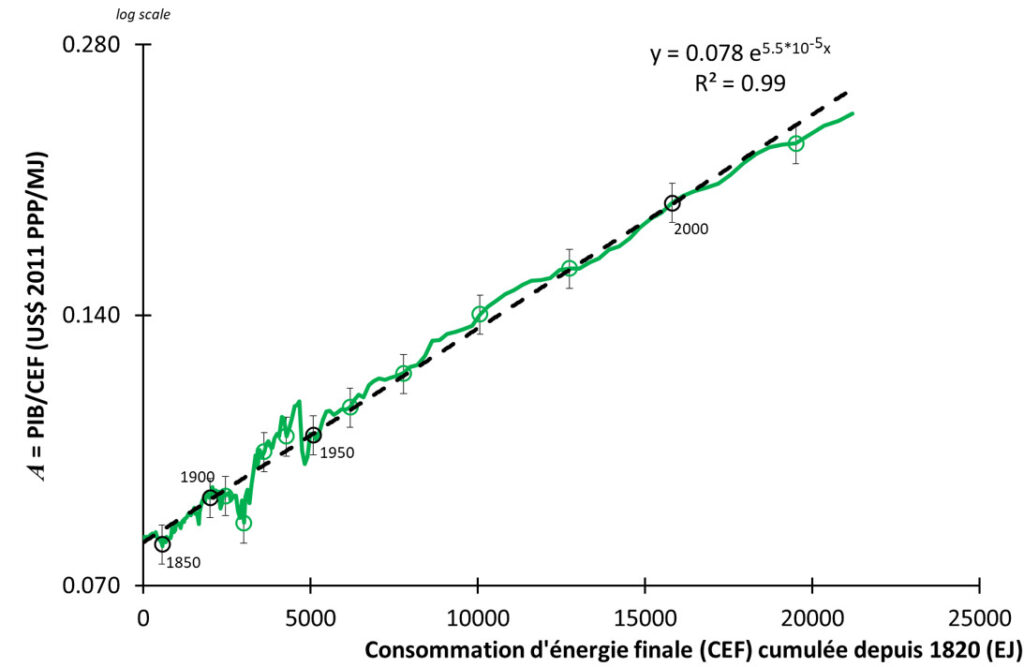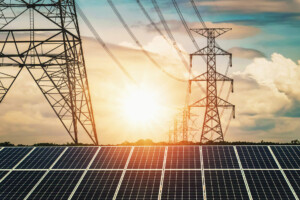Historical data on global energy consumption and economic activity is now increasingly detailed. This allows for a quantitative study of the increase in economic energy efficiency, defined as the ratio of global GDP to total final energy consumption by economic entities, machines, animals or humans, including their food. Over the last two centuries, this approach highlights exponential growth in this ratio as a function of cumulative energy consumption, reflecting a simple proportionality between economic activity and the ability to improve this ratio, and therefore to innovate.
This law allows us to project both backwards and forwards in time, based on existing estimates of GDP or energy. It is a new tool for analysing global economic trends in the current energy transition and for calibrating the many future scenarios against humanity’s historically demonstrated capacity to improve energy efficiency.
The global fight against climate change, both mitigation and adaptation, is largely a socio-economic and geopolitical challenge. A systemic approach, inspired by statistical physics, could provide useful insights for guiding energy and climate transition projects. The aim is to understand quantitatively how energy consumption, innovation and economic activity feed into each other on a global scale. In particular, this involves filling a gap: in most energy transition scenarios, as identified by the IPCC, assumptions about economic activity on the one hand and energy on the other are completely uncorrelated. The possibility of a rebound effect describing a link between efficiency gains and increased consumption is marginal or even non-existent in the underlying economic models.
At SPEC/SPHYNX, researchers have been interested in this global approach to the world economy for the past ten years. An initial publication [1] made it possible to analyse empirical data and various theoretical approaches. It became clear that it was crucial to consider both technical energy sources (fossil fuels, etc.) and all traditional forms of energy (fodder for draught animals, food for humans, firewood). This stage was followed by in-depth work on the data, aimed at standardising it consistently, as well as work on the underlying economic model in order to simplify the equations. The main result [2] highlights an exponential law linking final energy consumption (FEC) and energy efficiency (A) over the period 1820–2020:

where the parameter χ is obtained from the semi-logarithmic graph below:

Figure 1: Semi-logarithmic representation of global historical energy efficiency data A as a function of cumulative final energy consumption ( –––– ) and its approximation by equation 1 ( – – – ).
Equation 1 also allows us to analyse recent scenarios developed by the International Energy Agency. While current policies will lead to a continuation of the trend seen in the 2010s (STEPS, or Stated Energy Policy Scenario), the APS (Announced Pledges Scenario) brings us back in line with the exponential law shown in Figure 1, while the NZE (Net Zero Emissions) scenario (compatible with a 1.5°C target) assumes energy efficiency improvements on a scale never seen before.
References:
[1] An energy-based macroeconomic model validated by global historical series since 1820. Bercegol, H., & Benisty, H. (2022). Ecological Economics, 192, 107253.
[2] Bercegol, H. (2025). An equation for global energy efficiency gains in the long-run. Ecological Economics, 236, 108666.
Contact :
Hervé Bercegol IRAMIS/SPEC/SPHYNX.




